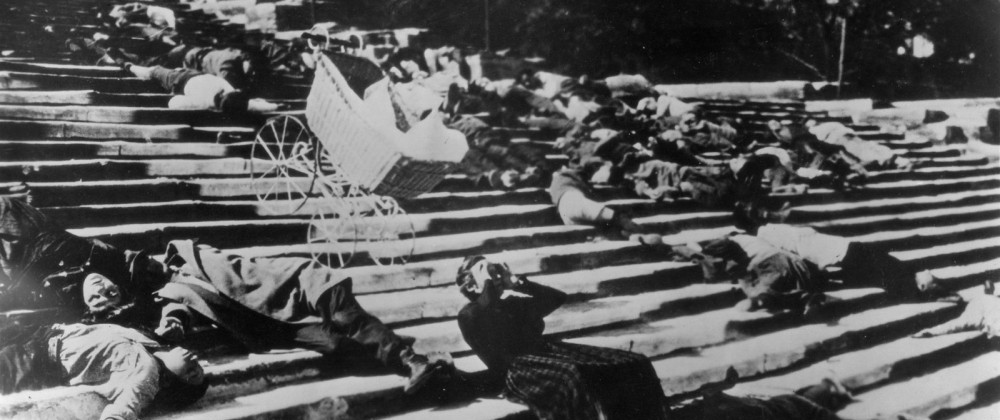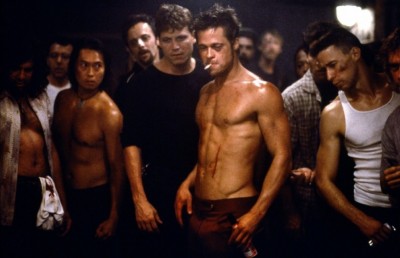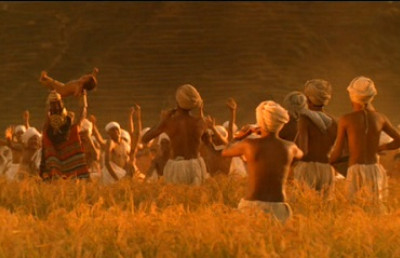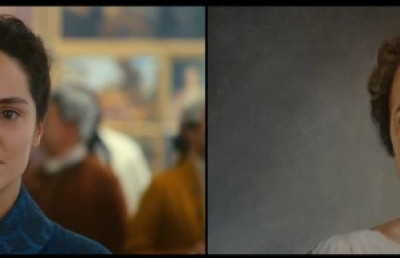Eisenstein: ‘Intellectual Montage’, Poststructuralism, and Ideology
Ideas on Montage

The great Soviet theorist and filmmaker Sergei Eisenstein explores the idea of creating an ‘intellectual cinema’ in three essays which were composed in 1929: Beyond the Shot, The Dramaturgy of Film Form, and The Fourth Dimension in Cinema. A central concern in these works is how a series of images can, when correctly composed by the filmmaker and then interpreted by the viewer, produce an abstract concept not strictly present in each of the composite images. He seeks to explicate this process by applying to cinema the dynamics he found in the Japanese hieroglyph. These essays, however, often feel more like brainstorming sessions then presentations of clearly formulated ideas. Part of the reason for this is that he does not subject either the kinds of meaning or the process by which meaning is produced by these ideograms to an especially rigorous analysis, but rather makes general statements which, upon inspection, seem problematic. A close analysis of such idea production, undertaken in this essay, reveals three possible kinds of ideas or mental representations: objects in reality, immaterial aspects of reality, and abstract concepts. And on the axis of combination, the rules which allow such meaning to be generated, by the hieroglyphs, is also brought out where they are assumed by Eisenstein. Against this tendency and in relation to the latter point, however, we also find in these essays an awareness of the possibility for ambiguous meanings and a search for ways to reduce or eliminate potential ambiguity. While it does not seem to be explicitly stated in the texts, Eisenstein seems to implicitly imply that this goal can be attained by setting up a dominant term which will limit the potential overflow of meaning. Interestingly, this strategy for producing meaning is one that has been explored in more recent cultural and literary studies, and which has important consequences for the notion of ideology. The following examples of the hieroglyphs are used by Eisenstein to illustrate a process of meaning generation which can be adopted by the cinema, in the service of ‘intellectual montage’.
eye + water = crying
door + ear = eavesdropping
child + mouth = screaming
mouth + dog = barking
mouth + bird = singing
knife + heart = anxiety
In response to the idea of the ideogram, Eisenstein concluded that montage is “an idea that DERIVES from the collision between two shots that are independent of one another_”. (95) This description seems to reverse the order in which the process actually unfolds in the spectator’s mind; it is not so much that the additive effect of two separate terms produce a new concept so much as the _a priori conventionally determined meaning gives special connotations to the terms which, taken as an aggregate, produce this meaning. For example, if we take the three terms above that involve the word mouth, without knowledge of the conventionally based meanings, it would just as reasonable to conclude that the resulting meaning was hunger. Assuming the production of a sound is the natural meaning that results from these terms can only arise once we know the conventional rules of combination, which constitute not only a kind of grammatical code but also an ideological privileging of one value over another. For example, if we were shown the first two hieroglyphs involving the term mouth, and were then asked about the meaning of mouth + bird, we would then be in a position to conclude singing, because the previous usage of the noun/sign ‘mouth’ functioned as the verb ‘to make the appropriate sound’ of the animal with which it was combined. This conclusion would be logical in a true sense of the term, and is the kind of inference Eisenstein seems to apply to all above examples independent of each other. On an ideological level, this grammatical rule of composition forms a binary opposition that places production (of sound) over consumption (of food). Eisenstein presents the process as one of logical induction of the final term when it is more accurately described as one of ideological deduction of the composite terms. As an interesting aside, from the perspective of Marxist/Communist ideological needs, the privileging of production over consumption would serve to direct the workers attention in the right direction by valuing contribution to the system over thoughts of what the system can give back.
Eisenstein goes on to comment that in this process we see how “material ideogram set against material ideogram produces transcendental result (concept).” (96) The problem with this statement lies in the suggestion that the resulting image (crying baby) is of a qualitatively different nature from the composite terms (mouth + child). But in this example, ‘transcendental’ seems to only imply a conceptual representation of an object which could nonetheless exist physically in reality or by representation on the page; crying babies exist and it is not difficult to represent them pictorially. The difficulty arises because by this definition of transcendental the material terms baby or mouth also contain a transcendental component as the image they produce continues to exist even after the image is no longer visible. We still retain the mental concept despite the fact that the material signifier is absent, as would necessarily be the case in an edited sequence of these two terms, in which the second term would replace the first. The material must be transcendental if it is to retain in our memory and allow us to arrive at the final conclusion. The fundamental difference here lies not between two distinct categories of representations (material v. transcendental), but rather between two processes which leads to the conception of these mental images, between direct representation and implication. Eisenstein seems to imply that a difference in the way in which an idea is produced necessarily changes the categorical nature of that idea, but there are many instances in which this is not the case. In this example both the terms and their product are conceptual representations of an object. It may change the feelings the viewer associates with that image, but that does not change the ontological nature of the image, any more than concern or repulsion for a crying baby changes the fact that it is a crying baby.
However, this is not to say that in the perceptual process there are not a variety of different kinds of representations at play. In the examples of the hieroglyphs provided, it is possible to distinguish two different forms of signification which correspond to separate types of ideas which need to be produced. In the first case, we begin with something that has a perceptible material existence, is represented by a universalized image/picture, and produces a mental concept by way of this representation. This is the case with a crying baby or singing bird. The second form of representation found in the examples arise in response to things which exist in the world but cannot be directly represented. This is the case with emotions. Anxiety is the only produced term in the list above which falls into this category. Because the feeling exits in the subject/person, as opposed to the object/world, the expression must be indirect (though of course the idea of a crying baby is also indirect insofar as it is not actually a crying baby). A common way of expressing this second kind of element is through a symptom it produces, such as a facial expression. In this case, the signifier would not be totally arbitrary because it is motivated by the signified, (though it would also not be a definitive expression because a number of emotions could in theory produce the same expression if the range of internal human emotions is greater that the possible contortions of the external human face). In summarizing this type of signification as outlined by the late semiotician Sol Worth, Dudley Andrew writes that “we do not decipher the code so much as we attribute meaning to what we sense. The signs of spring, as we call them, or of a coming storm, or of an illness are all natural signs by which we read nature.” (1984: 60).
While anxiety cannot be directly represented on account of its immateriality, it could be expressed by this kind of ‘natural’ sign (i.e., a facial gesture). Expressing it by two separate terms (knife + heart), however, constitutes it as an arbitrary category of signification which, again quoting Andrew, occurs “only in thoroughly symbolic situations where we treat the signifier as an expressed intention of another human agent” (1984: 60). The signifiers may bear a general relation to the signifieds because knives are able to inflict harm if used in a certain way and the heart, while not the source of emotion, is one area where we respond physiologically to heightened emotional states, mainly through an accelerated pulse. These general links are not enough to call the signs natural, though Eisenstein’s commentary on them seems to imply that this is the case. As with the mouth examples above, we would only be in a position to make these interpretations if we had knowledge of the code that would bring out these significations. In this sense, a series of arbitrary signs will appear natural when we subject them to an interpretative methodology which is itself arbitrary, and possibly ideological. That Eisenstein would characterize the separate terms as purely material seems particularly egregious in light of this example, where the terms knife and heart obviously contain meanings that go beyond what is represented.
It seems likely that part of the reason for Eisenstein’s underdeveloped commentary on the hieroglyph was he was using these examples from Japanese culture not on their own terms, but rather as a way of understanding the dynamics that could be applied to what he would call ‘intellectual cinema,’ and which would constitute a third form of representation which is more abstract then the two described above. It would seek to express ideas which were not only non-material, but which exist in a conceptual sense and in this regard go beyond things like emotions which while non-visible do have an empirical connection to objective reality. These kinds of ideas are generally broad claims which, while about the world, are highly abstract in a way which, unlike general scientific claims, can neither be proved or disproved with any degree of certainty. An example closer to Eisenstein would be to make a critical statement on the nature of religion, an example he employs in October (1928) and which is described below. To convey these kinds of ideas, which will not yield to direct material representations or ‘natural’ signs which imply their existence, it would be necessary to investigate the possibilities of combining ideas to produce new conceptions. His objective was to find ways in which a series of mental representations of empirical reality (visible and non- visible) can be combined to produce abstract notions which cannot be directly represented. If this is a rather commonplace conclusion to draw from his early essays, then it seems especially important to note that it is a conception of his task arrived at more thorough inference than an explicit rendering of what is on the page. In order to prevent the possible ambiguity which plagued the hieroglyphs, it is necessary to find a way to provide the viewer with a tool to effectively read the images. This challenge and a direction for the solution is expressed in the following quote, in which he addresses the possibility of ambiguity in a series of images:
This series might continue for a very long time before we finally come upon the signpost that ‘christens’ the whole series with a particular ‘sign’. This is why it is better to place this kind of indicator as near as possible to the beginning (in ‘orthodox’ construction). (…) It can be read only in context, just like a hieroglyph, acquiring specific meaning, sense and even pronunciation (sometimes dramatically opposed to one another) only in combination with a separate reading or a small sign or reading indicator placed along side it. (112)
A few paragraphs below these observations, he seems to be addressing this same issue of how to stabilize meaning, by introducing the idea of the dominant:
In a word a whole complex of secondary stimulants always accompanies the central stimulant. (…) There, alongside the resonance of the basic dominant tone, there is a whole series of secondary resonances, the so-called overtones and undertones. Their collision with one another and with the basic tones, etc., envelops the basic tone with a whole host of secondary resonances. (112)
The fundamental notion which seems to be implicit in these comments, and which addresses the way in which meaning must be stabilized, is related to the methods described above in relation to the hieroglyphs. The ‘reading indicator’ he speaks of in the first quote arises though the privileging of tones which brings out the possible secondary meanings produced by the overtones mentioned in the second extract. The closest Eisenstein comes to explicitly stating this idea occurs toward the end of the Fourth Dimension, when he writes that intellectual cinema “will be the cinema that resolves the conflicting combination of physiological overtones and intellectual overtones…” (123). While speculative, it is possible that it was an awareness of the need to stabilize meaning that led him to favor the idea of the dominant over the promotion of an equalization of the different elements of cinema. This idea of the stabilization of meaning is, of course, central to poststructuralist theory and in his section on Derrida, is neatly summarized by Hans Bertens, who writes that “texts set up one or more centers –derived from the language they make use of– that must give them stability and stop the potentially infinite flow of meaning that all texts generate” (128). Applied to language, this claim can often seem difficult and excessively theoretical, but makes immediate sense when applied to a series of images which, as would be the case with ‘intellectual cinema,’ intend to communicate ideas with an intellectual clarity equal to language, but with an emotional force of far greater impact. While perhaps lacking in emotional impact, the deconstruction of the hieroglyphs illustrated the possibility for a multitude of possible meanings to arise, and the correction of this problem by the establishment of an ideological privileging (production over consumption) that limits the meaning.
While Eisenstein’s thinking seems to be heading in the direction of a notion of meaning stabilization though the use of the dominant, which has much in common with elements of poststructuralism, his conception of this process is very different from this tradition; he does not seem to conceive of it as a highly conventional and arbitrary way of generating meaning, but rather as a way of affecting a natural way of thinking. This can be observed in his description of the God scene from October, which he claims “_unleashes a process that, in terms of its form, is identical to a process of logical deduction_” (108). But the meaning of this scene, which begins with an image of a conventional god and then gradually replaces it with a series of lesser and lesser gods, is by no means clear. It could be taken to show how the universal truth of God is present in a variety of representations, or perhaps could be a statement that there is only one God, in effect a warning against idolatry. Eisenstein’s intended message that the original image of the divine is as false as those that follow does not have any obvious superiority over these other interpretations, when taken in and of itself. But numerous other sections of October serve to establish the privileging of real people over various statues, which are to be seen in a negative way. Two prominent examples are the pulling down of the statue of Alexander III at the film’s opening and the parody of the Napoleon statuette. (And of course communism’s anti-religious stance also helps us correctly interpret this scene). In this way, the numerous ‘overtones’ that could be produced by the image of God are made finite. In light of this system of privileging, there is something redundant about placing it in a context with lesser religious symbols, since the image has already been denigrated through the establishing of a negative term, through the establishing of a reading code.
Throughout his writing, Eisenstein consistently refers to his goal as the molding of the viewer’s mind in a direction tightly preconceived by the artist. Indeed, early on in the 1920s he referred to the viewer’s mind as the raw material of cinema, with his initial investigations leading to an exploration of reflexology. By the late 1920s, his approach to this aim was moving towards the establishment of a so called ‘intellectual cinema’ and the related goal of understanding how images could be combined so as to provide the viewer with an awareness of abstract concepts. On a superficial level, such indoctrination by images would seem to arise by the ideas and values conveyed in the films. But in trying to arrive at a means of producing abstract concepts, and to limit the possible overflow of meaning, his writings hint at strategies which would establish not just the ideas to be thought, but also the mode of thinking, the grammatical code, which could produce these ideas. Such a code would function by establishing dominant values which could function as a kind of intellectual legend of various images. From the point of view of ideology propagation, this is perhaps a much more significant project than delivering mere slogans. In an kind of extreme version of an fictional history, one can almost imagine his proposed film version of Das Capital as an impenetrable cluster of images to the non-indoctrinated, but a logical and seemingly obvious explication of Marxist principles to the people of the Soviet Union. This difference is between presenting the objects of thought and mounting the very processes of thought itself. While the former is overt and didactic, the latter is subtle and unlikely to even be detected by the viewer.
Eisenstein was in many ways an extraordinarily prescient thinker. By implicitly suggesting the use of a dominant in order to limit meaning so as to produce ideology, he may well have been almost half a decade ahead of his time in foreseeing certain kinds of ideas that would come to be characterized under the rubric of poststructuralism. A major difference, of course, is that Eisenstein was looking at how to produce this kind of meaning, while poststructuralist thinkers are more interested in deconstructing it. Another difference is that there are times when Eisenstein takes natural modes of thought for those that are actually highly conventional, and in this sense related to ideology. That one of the cinema’s greatest rhetoricians of ideology did not always notice its place in his own analyses is perhaps a testament to the subtle and inescapable nature of the ideological.
Bibliography
Andrew, Dudley. The Major Film Theories. New York: Oxford University Press, 1976.
Andrew, Dudley. Concepts in Film Theory. New York: Oxford University Pres, 1984.
Bertens, Hans. Literary Theory, The Basics. London: Routledge, 2001.
Bordwell, David. The Cinema of Eisenstein. Cambridge: Harvard University Press, 1993.
Christie, Ian and Richard Taylor, ed. Eisenstein Rediscovered. London: Routledge, 1993.
Eisenstein, Sergei. The Eisenstein Reader. Ed. Richard Taylor. Trans. Richard Taylor and William Powell. London: BFI, 1998.
Lavalley, Al, and Barry P. Scherr, ed. Eisenstein at 100. Piscataway, NJ: Rutgers, 2001.
Lehman, Peter. Ed. Defining Cinema. New Brunswick, NJ: Rutgers, 1997.













